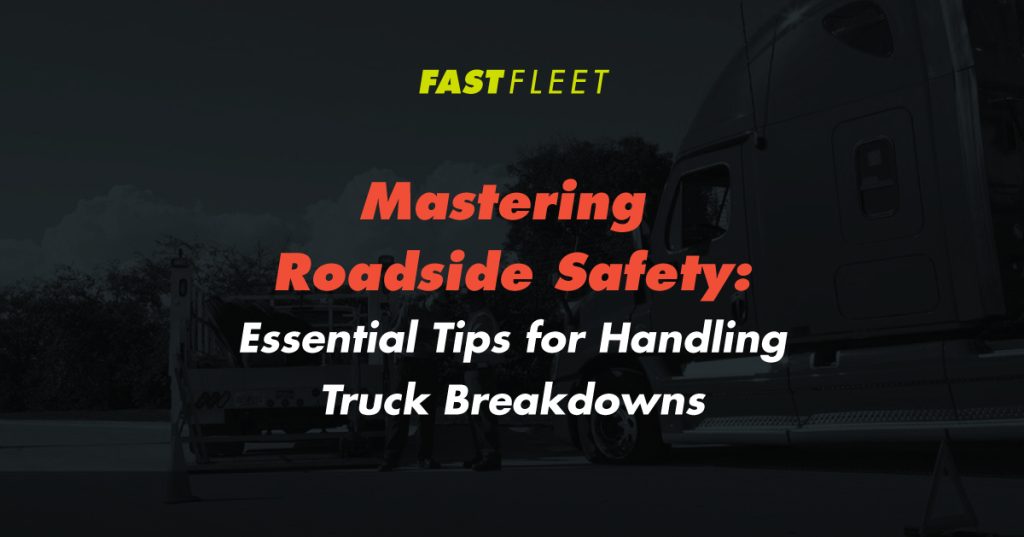Mastering Roadside Safety: Essential Tips for Handling Truck Breakdowns
As a truck driver or fleet manager, you understand the challenges of navigating long hauls and ensuring timely deliveries.
However, the trucking industry is no stranger to unexpected breakdowns, which can disrupt schedules and pose safety risks.
That’s why mastering roadside safety is crucial for all involved in the trucking business. In this blog, we will provide essential tips on how truck drivers and fleet managers can efficiently handle truck breakdowns and promote overall roadside safety.
From identifying common hazards to creating a well-thought-out emergency plan, we’ll cover everything you need to know to stay prepared and keep the wheels rolling.
Understanding Roadside Hazards
Roadside safety is of paramount importance for truck drivers and fleet managers. It begins with a thorough understanding of potential hazards unique to the trucking industry.
By being aware of these hazards, drivers can make informed decisions and take necessary precautions to minimize risks on the road.
Navigating Heavy Traffic Areas: Truck drivers frequently encounter heavy traffic areas, especially near urban centers and during peak travel times.
Maneuvering large vehicles amidst congested traffic can be challenging, increasing the risk of accidents and collisions.
Drivers need to maintain a safe following distance, use turn signals appropriately, and exercise extra caution when changing lanes to avoid potential collisions.
Limited Parking Spaces: Finding suitable parking spaces for commercial trucks can be a struggle, particularly in busy rest areas and truck stops.
Limited parking options may lead to drivers parking in unsafe locations, such as shoulders or exit ramps, risking fines and creating traffic hazards.
Fleet managers should encourage drivers to plan their routes to include designated truck parking areas and rest stops to avoid such situations.
Adverse Weather Conditions: Weather conditions can change rapidly and pose significant challenges for truck drivers.
Rain, snow, ice, and fog can reduce visibility and affect road traction, making driving hazardous.
Drivers must adjust their driving speed and behavior accordingly, maintain safe stopping distances, and use appropriate lighting in low-visibility conditions.
Construction Zones: Construction zones are common on highways and roads, requiring drivers to navigate through reduced lanes, detours, and road obstructions.
Drivers must slow down and stay alert in construction zones to protect workers, prevent accidents, and avoid potential fines for violating speed limits.
Other Vehicles and Pedestrians: Sharing the road with other vehicles and pedestrians is an everyday challenge for truck drivers.
Maneuvering through busy traffic and being mindful of smaller vehicles, motorcycles, and pedestrians is essential to prevent collisions and ensure road safety for everyone.
Cargo Security: During breakdown situations, ensuring the security of the cargo is crucial.
Thieves may take advantage of vulnerable vehicles to attempt cargo theft.
Drivers must remain vigilant, lock their vehicles when unattended, and report any suspicious activities to the appropriate authorities.
Understanding and being aware of roadside hazards specific to the trucking industry are vital for every truck driver and fleet manager.
Navigating heavy traffic areas, finding suitable parking, handling adverse weather conditions, and staying cautious in construction zones are all critical aspects of ensuring safety on the road.
Additionally, drivers must remain vigilant about other vehicles, pedestrians, and the security of their cargo during breakdown situations.
By prioritizing roadside safety and taking proactive measures, truck drivers and fleet managers can contribute to a safer road environment for all road users.
Creating a Roadside Emergency Plan
An effective roadside emergency plan is not just a document; it’s a critical aspect of every fleet’s safety strategy. Having a well-thought-out plan in place can be the key to swift resolution and minimal downtime during breakdown situations.
Here are actionable steps to create a comprehensive roadside emergency plan:
Assigning Roles and Responsibilities:
-
- Designate a primary contact person (dispatcher or fleet manager) responsible for coordinating the response during breakdowns.
- Assign specific roles to drivers, such as communicating with roadside assistance, securing the vehicle and cargo, and providing updates to the fleet manager.
Example: Driver A is responsible for contacting roadside assistance, while Driver B is in charge of securing the vehicle and cargo during the breakdown.
Establishing Clear Communication Procedures:
-
- Define the preferred communication channels for reporting breakdown incidents, such as phone calls, text messages, or a dedicated communication app.
- Ensure all drivers have access to necessary communication tools, including smartphones or two-way radios.
Example: Drivers are instructed to immediately call the designated emergency hotline in case of a breakdown and provide their exact location and vehicle details.
Ensuring Access to Essential Emergency Contact Information:
-
- Compile a list of important emergency contacts, including roadside assistance providers, towing companies, repair shops, and relevant law enforcement agencies.
- Distribute this list to all drivers and ensure it is readily available in the vehicles, both in physical and digital formats.
Example: Each driver is given a laminated card with essential emergency contact numbers to keep in their glove compartment for easy access.
Conducting Regular Emergency Response Drills and Training:
-
- Organize routine emergency response drills to simulate breakdown scenarios and practice the roadside emergency plan with drivers and fleet members.
- Provide training on specific actions to take during different types of breakdowns, emphasizing safety protocols and communication best practices.
Example: Once a quarter, the fleet conducts surprise emergency drills where drivers are evaluated on their response to various breakdown scenarios.
Documenting the Roadside Emergency Plan:
-
- Create a comprehensive document outlining the entire roadside emergency plan, including roles, responsibilities, communication procedures, and emergency contact information.
- Ensure all drivers and fleet members have access to this document and are familiar with its contents.
Example: The roadside emergency plan is stored in a shared digital folder accessible to all drivers via their fleet management app.
A well-executed roadside emergency plan is the backbone of fleet safety, providing drivers and fleet managers with the confidence and preparedness to handle breakdown situations effectively.
By assigning roles, establishing clear communication procedures, ensuring access to essential contacts, and conducting regular training, fleets can minimize downtime and prioritize safety during roadside emergencies.
Preparedness and practice are the keys to making the difference between a potential crisis and a swift resolution on the road.
Step-by-Step Guide for Handling Truck Breakdowns
When faced with a truck breakdown, knowing what steps to take can make the process smoother and safer.
Here’s a detailed step-by-step guide to handling truck breakdowns:
Immediate Response:
-
- Safely pull over to the shoulder: As soon as you notice signs of a breakdown, steer your truck to the shoulder of the road to get out of the flow of traffic. Use your hazard lights to signal other drivers of your situation.
- Assess the severity of the breakdown: Try to determine the cause of the breakdown if it is apparent and assess the severity of the situation. If you suspect a mechanical issue that could be dangerous, err on the side of caution and prioritize personal safety.
Contacting Roadside Assistance:
-
- Reach out to your roadside assistance provider: Have your roadside assistance provider’s contact information easily accessible and call them immediately to report the breakdown. Provide accurate details about your location, including the nearest mile marker, landmarks, or any available GPS coordinates.
- Inform emergency services if necessary: If the breakdown occurs in a hazardous location or involves injuries, contact emergency services (such as 911) to request immediate assistance.
Ensuring Personal Safety:
-
- Stay inside the vehicle or move to a safe area: If it is safe to do so, remain inside the truck with your seatbelt on while waiting for assistance. If staying inside is not safe due to traffic or other hazards, move to a safe area away from the road and traffic.
- Use warning devices: If you have reflective triangles or flares, place them a safe distance behind your truck to warn approaching vehicles.
Monitoring and Communicating:
-
- Stay informed about the estimated arrival time: Keep in contact with your roadside assistance provider to stay updated on their estimated arrival time. This will give you a better idea of how long you may need to wait.
- Coordinate updates with dispatch and fleet management: Inform your dispatch or fleet management about the breakdown and provide them with regular updates on your status. This ensures they can adjust schedules or plan alternative routes if necessary.
Stay Prepared with Emergency Essentials:
-
- Carry an emergency kit: Keep a well-stocked emergency kit in your truck, including essential items like a first aid kit, flashlight, extra clothing, drinking water, non-perishable food, and a fully charged mobile phone.
- Know your company’s protocols: Familiarize yourself with your company’s specific breakdown procedures and follow them accordingly.
Handling a truck breakdown requires a calm and methodical approach to ensure both personal safety and swift resolution.
By following this detailed step-by-step guide, you can respond efficiently and safely during breakdown situations. Remember, immediate response and contacting roadside assistance are crucial first steps, followed by ensuring personal safety and staying informed through communication with both roadside assistance and fleet management.
Staying prepared with an emergency kit and knowing your company’s protocols will contribute to a well-handled breakdown and minimize potential disruptions in your trucking operations.
Breakdown Prevention Tips
While handling breakdowns is essential, preventing them in the first place is even better. Employing proactive measures can significantly reduce breakdown-related risks, enhance safety, and improve overall fleet performance.
Here are some breakdown prevention tips to keep your trucks on the road and operating smoothly:
Regular Truck Maintenance:
-
- Schedule routine inspections and maintenance checks: Implement a comprehensive maintenance schedule for all your trucks, covering engine, transmission, brakes, suspension, and other critical components. Regular maintenance helps identify and address potential issues before they escalate into costly breakdowns or safety hazards.
- Address potential issues promptly: If any problems or concerns are identified during routine inspections, address them promptly. Waiting to resolve small issues can lead to more significant problems down the road, potentially resulting in extended downtime and higher repair costs.
Tire Care and Maintenance:
-
- Regularly check tire pressure and tread depth: Proper tire maintenance is crucial for optimal performance and safety. Check tire pressure regularly and maintain it at the recommended levels to ensure even wear and reduce the risk of blowouts. Additionally, monitor tire tread depth to ensure it meets legal requirements and provides adequate traction on the road.
- Carry spare tires and necessary tools: Equip your trucks with spare tires and the necessary tools for quick tire replacements. This will enable drivers to handle tire issues efficiently without relying solely on roadside assistance.
Monitoring Vehicle Systems:
-
- Utilize advanced telematics and diagnostic technology: Implement telematics systems that can monitor various vehicle systems in real-time, such as engine performance, fuel efficiency, and diagnostic trouble codes. These systems can help detect warning signs and dashboard indicators promptly, allowing for proactive maintenance and addressing potential problems before they escalate.
Driver Training and Education:
-
- Provide ongoing driver training: Educate your drivers on best practices for vehicle operation, maintenance checks, and identifying warning signs of potential issues. Well-informed drivers can take proactive measures and report concerns promptly, contributing to breakdown prevention.
- Promote responsible driving habits: Encourage drivers to operate their vehicles responsibly, avoiding aggressive driving, sudden braking, and excessive speeding. Responsible driving can reduce wear and tear on the truck’s components and improve fuel efficiency.
Emergency Preparedness:
-
- Equip drivers with emergency kits: Ensure that each truck is equipped with an emergency kit containing essential items such as first aid supplies, reflective vests, warning triangles, and basic tools. These kits can prove invaluable during breakdown situations or other roadside emergencies.
- Provide clear breakdown procedures: Establish clear protocols for drivers to follow in the event of a breakdown. Ensure that drivers know who to contact, the necessary information to provide, and the steps to take to ensure their safety and the security of the vehicle and cargo.
Implementing effective breakdown prevention tips is crucial for fleet managers and drivers alike. Regular maintenance checks, tire care, advanced monitoring systems, driver training, and emergency preparedness can collectively contribute to reducing breakdown-related risks and enhancing fleet performance.
By prioritizing proactive measures, fleets can minimize downtime, reduce repair costs, and improve overall safety on the road, ultimately leading to a more efficient and successful trucking operation.
Mastering roadside safety is an indispensable skill for every truck driver and fleet manager.
By understanding roadside hazards, creating a robust emergency plan, and following a step-by-step guide for breakdown situations, you can ensure safety and efficiency on the road.
Embrace proactive measures like regular maintenance and monitoring to minimize breakdown risks and enhance overall roadside safety.
Remember, preparedness and quick response are the keys to mastering roadside safety and keeping your fleet on track for success.
Stay safe, stay prepared, and keep the wheels turning!
















